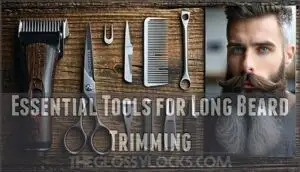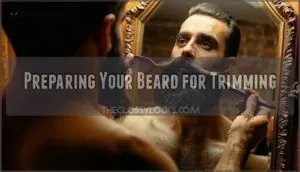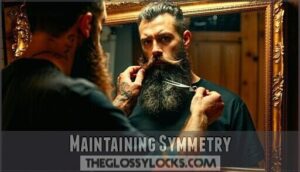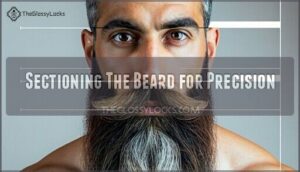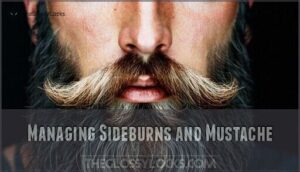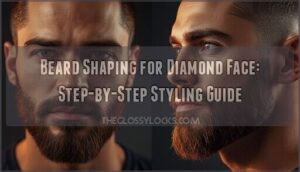This site is supported by our readers. We may earn a commission, at no cost to you, if you purchase through links.

Start by washing and conditioning your beard, then work in manageable sections using scissors for length control and clippers for neckline definition. The key lies in maintaining your beard’s natural shape while addressing split ends and uneven growth patterns.
Smart trimming preserves months of growth while eliminating the scraggly appearance that sabotages even the most impressive beards.
Table Of Contents
- Key Takeaways
- Choosing The Right Long Beard Style
- Essential Tools for Long Beard Trimming
- Preparing Your Beard for Trimming
- Defining The Neckline and Cheek Line
- Trimming Techniques for Long Beards
- Managing Sideburns and Mustache
- Maintaining Shape and Length
- Conditioning and Hydrating Long Beards
- Advanced Styling and Finishing Touches
- Common Long Beard Mistakes to Avoid
- Frequently Asked Questions (FAQs)
- How to trim a long beard?
- How do you trim a beard if you have a patchy beard?
- When should you trim your beard?
- How to trim a beard like a pro?
- How do you manage a long beard?
- How do you trim a beard with a clipper?
- What to do when beard gets long?
- How can I reduce the length of my beard?
- How do you edge a long beard?
- How do you trim a long stubble beard?
- Conclusion
Key Takeaways
- You’ll protect months of growth by using quality trimmers with adjustable guards and sharp scissors for precision work rather than rushing with inferior tools
- You should establish clear neckline and cheek boundaries first, then work systematically in manageable sections to prevent uneven cuts and maintain your beard’s natural shape
- You need to trim conservatively every 2-3 weeks, removing split ends and wispy hairs while preserving length through gradual adjustments rather than dramatic cuts
- You must maintain daily conditioning with beard oil and regular brushing to keep your long beard healthy, manageable, and ready for precise trimming sessions
Choosing The Right Long Beard Style
Selecting the right long beard style isn’t just about personal preference—it’s about understanding how your face shape, hair texture, and lifestyle work together.
You’ll want to think about whether your beard grows thick or patchy, if your face is round or angular, and how much daily maintenance fits your routine.
Matching Beard Styles to Face Shape
Through strategic Face Shape Analysis, you’ll master Beard Symmetry by selecting Long Beard styles that complement your natural features. Oval faces suit most Facial Hair Styles, while square faces need Jawline Enhancement through chin-focused growth. Round faces require Cheekbone Accentuation with shorter sides and longer bottoms. Diamond faces achieve Facial Harmony by balancing prominent cheekbones with strategic Beard Maintenance techniques.
Considering Hair Texture and Density
Your beard’s texture and density determine which trimming techniques work best for your Long Beard. Coarse hair requires different approaches than fine strands, while thick growth patterns need strategic thinning techniques. Understanding your Hair Porosity helps you choose proper Beard Care Tips for ideal Texture Management.
- Curl Patterns: Wavy beards need longer guard settings to account for shrinkage when trimmed
- Beard Thickness: Dense growth benefits from thinning shears to prevent bulk and improve shape
- Frizz Control: High-porosity hair requires more conditioning between Beard Trimming sessions
Cultural and Personal Style Influences
Your beard’s Cultural Significance reflects centuries of Masculine Norms and Personal Expression. Different cultures celebrate distinct Beard Styles, from Viking warriors to modern hipsters. Your Long Beard becomes your Beard Identity, signaling values and lifestyle choices. Consider how your chosen style aligns with professional expectations while honoring your heritage and Style Evolution. Understanding the importance of classic beard styles for men can help you make informed decisions about your beard care and maintenance.
| Culture | Traditional Style | Modern Adaptation |
|---|---|---|
| Viking/Nordic | Full, untamed lengths | Structured Yeard with defined edges |
| Middle Eastern | Dense, rounded shapes | Corporate-friendly full beard |
| Hipster/Western | Artfully disheveled looks | Precision-trimmed Bandholz style |
| Professional | Clean, conservative lines | Power Beard with sharp definition |
Essential Tools for Long Beard Trimming
You’ll need the right tools to transform your long beard from unruly to polished without sacrificing its impressive length.
Quality beard trimmers with multiple guard lengths and sharp scissors work together to tackle everything from bulk removal to precision detailing.
The right tools transform wild whiskers into groomed greatness—no compromises, just precision
Selecting Quality Beard Trimmers and Scissors
When investing in quality trimmer blades crafted from Japanese stainless steel, you’ll notice cleaner cuts that won’t snag your long beard like cheaper alternatives. Professional-grade scissor materials with titanium coatings resist corrosion while maintaining razor-sharp precision for detailed trimming techniques.
Your grooming kits should feature adjustable guards for various beard lengths, ensuring consistent beard maintenance tips across your entire routine. Using proper beard trimmer techniques is essential for achieving a well-groomed long beard.
Using Beard Combs and Brushes
Two essential tools transform your Long Beard maintenance routine: quality combs for Beard Detangling and brushes for Hair Smoothing. Choose wide-tooth wooden Comb Materials over plastic—they won’t snag or create static. Boar bristle Brush Styles distribute natural oils while Beard Taming unruly sections.
Master these Beard Care fundamentals, and your Beard Trimming sessions become precision operations rather than wrestling matches. Using the right beard comb tools can make a significant difference in achieving a well-groomed beard.
Preparing Your Beard for Trimming
Proper preparation transforms a potentially messy trimming session into a precise grooming experience. You’ll want to start with a clean, detangled beard that’s been properly conditioned and dried to guarantee even cuts and prevent snagging.
Washing and Conditioning Your Beard
Proper cleansing sets the foundation for precise trimming. Start with specialized beard shampoo twice weekly to remove buildup without stripping natural oils. Follow with quality conditioning tips—apply conditioner from mid-length to ends, avoiding roots. Rinse thoroughly with cool water to seal hair cuticles.
Weekly deep conditioning treatments using beard oil improve hydration techniques. This beard care routine promotes healthy beard growth while preparing your long beard for ideal trimming results through proper skin care and beard care and maintenance practices. Using a beard wash routine is essential for achieving the best trimming results and maintaining a healthy beard.
Towel Drying and Detangling
After washing, gently blot your long beard with microfiber towels instead of rubbing vigorously. This hair minimization technique prevents breakage and frizz.
Apply detangling sprays to stubborn knots, then work through tangles using wide-tooth beard combs starting from the tips upward.
Gentle blotting preserves your beard’s natural oils while preparing it for precise beard trimming and long beard maintenance.
Brushing for Evenness
Beard brushing creates the foundation for precise Long Beard trimming by facilitating proper Hair Distribution throughout your facial hair. Think of your brush as a sculptor’s tool—it reveals your beard’s true shape and identifies uneven areas before you make any cuts.
- Use downward strokes to align hair fibers and showcase natural Beard Growth patterns
- Focus on areas where Beard Texture varies to achieve consistent Daily Maintenance results
- Brush against the grain briefly, then with it to boost volume and identify thin spots
- Target problem areas twice to guarantee Even Trimming preparation for various Beard Styles and Mens Grooming needs
Defining The Neckline and Cheek Line
Your neckline and cheek line create the foundation that transforms a wild beard into a polished masterpiece. You’ll want to establish these boundaries early, as they define your beard’s overall shape and prevent that "mountain man lost in civilization" look.
Identifying Your Ideal Neckline
Your Adam’s apple becomes your best friend when neckline shaping—place two fingers above it to find the sweet spot. This proven technique creates perfect beard symmetry while enhancing jawline definition and facial structure. The curved line from ear to ear through this point ensures hairline blending that complements your beard styles and facilitates healthy beard growth techniques.
Understanding proper beard neckline maintenance is essential for a polished appearance.
Shaping The Cheek Line
After establishing your neckline, your cheek line deserves equal attention for proper facial hair mapping. Start by identifying your natural cheekbone structure – this guides where your beard should end for ideal jawline definition.
Use your trimmer’s shortest guard to create clean edges, following your bone structure rather than fighting it. Proper cheek line trimming prevents that "caveman" look while maintaining beard symmetry and enhancing your facial features.
Maintaining Symmetry
Once you’ve shaped your cheek line, achieving perfect Facial Balance becomes your next priority. Asymmetry Correction requires constant mirror checks and steady hands to master Beard Alignment.
Use these Symmetry Techniques for perfect Proportion Guidance:
- Step back from the mirror every few trims to assess overall balance
- Use your phone’s front camera to spot subtle inconsistencies your eyes miss
- Mark reference points with a washable marker before major adjustments
- Trim conservatively—you can always remove more hair but can’t add it back
Remember, even experienced barbers use multiple angles when perfecting Beard Fade shifts on Long Beard styles.
Maintaining a clean beard neckline involves understanding neckline maintenance techniques to achieve a polished look.
Trimming Techniques for Long Beards
Mastering long beard trimming requires strategic techniques that prevent damage while maintaining your desired style. You’ll need to section your beard systematically, choose between scissors and clippers based on your goals, and address problematic areas like split ends with targeted precision.
Sectioning The Beard for Precision
With your neckline and cheek line properly defined, you’ll want to break your long beard into manageable sections for precision trimming. Think of beard mapping as creating a roadmap—divide your facial hair into distinct zones for systematic grooming. This sectioning technique prevents uneven cuts and guarantees symmetry guidance throughout your trimming process.
| Beard Section | Trimming Focus | Key Technique |
|---|---|---|
| Upper Cheeks | Light maintenance | Follow natural growth patterns |
| Mid-Beard | Length control | Work in small increments |
| Lower Chin | Shape definition | Use vertical sectioning |
Trimming With Scissors Vs. Clippers
When facing the choice between scissors and clippers for long beard trimming, precision trumps speed. Scissor techniques offer unparalleled control for beard texture management, preventing the hair pulling that clippers cause on longer growth. While clippers excel at quick uniform cuts, cutting methods with scissors reduce split ends and maintain beard styles naturally.
Professional trimming tools like quality scissors become essential for long hair and beard maintenance, ensuring your beard trimming sessions deliver salon-worthy results. Great barbers understand the importance of using the right tool for the job, considering factors like haircutting tools to achieve the best results.
Addressing Split Ends and Wispy Hairs
Long beards develop split ends from daily wear, requiring targeted split end repair through precise trimming. Snip damaged ends with sharp scissors, then apply beard serum benefits for hair follicle care.
Combat wispy hair solutions by removing straggly pieces during your beard trimming routine. Use frizz prevention techniques with quality beard oil after trimming sessions.
Regular maintenance prevents long hair and beard damage while promoting healthy beard growth.
Managing Sideburns and Mustache
The sideburns and mustache frame your long beard, so you’ll want to blend them uniformly for a polished, professional appearance.
Proper trimming techniques prevent harsh lines while maintaining your beard’s natural flow from face to chin.
Blending Sideburns Into Beard
Your sideburn trimming technique determines whether your facial hair looks polished or patchy. Start by identifying where your sideburns naturally meet your beard growth – this creates your roadmap for a cohesive blend.
Perfect sideburn integration requires these steps:
- Use a beard fade technique, starting with longer guards at the temple
- Create natural connection points by gradually decreasing guard lengths downward
- Blend beard layering from sideburns using upward trimming motions
- Check symmetry constantly – your long hair and beard should frame your face evenly
Trimming and Styling The Mustache
Your mustache demands the same attention as your long beard for a cohesive look. Comb mustache hairs down, then trim with scissors just above your upper lip, following the natural curve. For Chevron Mustache styles, use beard trimming scissors for precision cuts.
Apply mustache waxing products sparingly to tame unruly facial hair without creating a greasy appearance that clashes with your carefully maintained stache care routine.
Avoiding Over-Trimming
Over-trimming can ruin months of careful beard growth in seconds. Start with longer trimmer settings and gradually work shorter—you can’t put hair back once it’s gone.
Keep your cutting errors minimal by trimming small sections at a time, checking beard symmetry frequently. Remember: trimming techniques for your full beard require patience and light touches to maintain proper length control.
Maintaining Shape and Length
Once your long beard reaches power beard status, you’ll need to think of it more like topiary than hair. Regular shaping sessions every 2-3 weeks keep your beard looking intentional rather than like you’ve been stranded on a desert island.
Keeping a Consistent Beard Shape
Professional beard symmetry demands consistent reference points throughout your trimming routine. Map your facial structure first, identifying natural contours that’ll guide your blade work.
Your hair texture determines which trimming techniques work best—coarse beards need aggressive sectioning, while fine hair requires gentler approaches.
Beard geometry isn’t rocket science, but it does require patience and systematic thinking for that perfect full beard shape.
Techniques for Even Length
Achieving even length across your long beard requires methodical precision cutting and consistent trimming guides. Use your comb to lift sections at identical angles, creating uniform beard symmetry throughout each area.
Work systematically from one side to the other, maintaining the same guard length on your trimmer for full beard consistency.
Check your progress frequently in good lighting, as even edges depend on careful length control and patience during each trimming session.
Treating Your Beard Like a Hedge
Think of your long beard as a topiary masterpiece requiring strategic beard pruning. Just like hedge sculpting, precision trimming means stepping back frequently to assess your full beard’s overall shape.
Trim small sections at a time, maintaining the beard styles you’re aiming for through careful facial hair management and consistent beard trimming techniques.
Conditioning and Hydrating Long Beards
Long beards need consistent moisture to prevent the brittle, straw-like texture that makes trimming a nightmare.
You’ll want to establish a daily conditioning routine that keeps both your beard hair and the skin underneath healthy and hydrated.
Applying Beard Oil and Balm
Quality beard oil benefits long beards through daily moisture protection, while balm application provides styling control and skin hydration. Your beard softening routine starts with these essentials:
- Warm oil between palms before applying to towel-dried facial hair styles
- Use dime-sized amounts for beard trimming maintenance on longer lengths
- Distribute evenly with oil blending techniques through beard and mustache areas
- Apply balm for hold after oil absorption completes
Regular use of beard care products can improve the overall health and appearance of your beard.
Benefits of Leave-in Conditioner
Leave-in conditioner acts like a protective shield for your long beard, delivering continuous hair hydration throughout the day. This grooming essential excels at beard softening while providing exceptional frizz reduction compared to rinse-out products.
You’ll notice improved beard shine and improved manageability, making your facial hair easier to style and maintain between washes.
Preventing Dryness and Breakage
Long beards require consistent Beard Moisturizing to prevent Hair Breakage and maintain healthy Mens Facial Hair. Proper Beard Conditioning combats Dry Skin Care issues, while Split End Repair techniques preserve length.
Apply Beard Oil daily, focusing on split-prone ends where your beard’s like a fraying rope.
Master these Grooming Tips to keep your Beard and Mustache looking sharp across all Beard Styles for Men.
Advanced Styling and Finishing Touches
Once you’ve mastered the basics of long beard maintenance, it’s time to refine your grooming game with professional finishing techniques. These sophisticated methods transform a well-maintained beard into a masterpiece that showcases your attention to detail and personal style.
Creating Fades and Defined Edges
Creating professional beard fade techniques transforms your Full Beard into a masterpiece of precision cutting. Start with longer guards at cheekbones, gradually decreasing toward your neckline for fluid connections. Use upward flicking motions to blend harsh lines naturally.
Sharp edge trimming defines your jawline perfectly, while defined lines separate amateur attempts from expert beard styles. This finesse in beard shaping is what sets a well-groomed look apart.
Polishing With Beard Grooming Brushes
After achieving clean edges and fades, your brush becomes the secret weapon for professional polish. Quality Brush Care Tips start with selecting proper Beard Brush Materials – boar bristle for density, synthetic for sensitive skin. Your Grooming Brush Sizes matter: smaller for precision work, larger for overall styling.
Here’s your polishing arsenal:
- Boar bristle brushes distribute Beard Oil evenly, creating that coveted shine
- Soft Bristle Brushes smooth flyaways without damaging delicate Facial Hair
- Round brushes shape your Beard and Mustache while adding natural volume
- Clean brushes weekly using warm water and mild soap for peak performance
Proper Brush Maintenance Techniques keep your tools performing like new. Clean bristles weekly, store properly, and replace when worn. Your Beard Styles deserve premium treatment.
Using Beard Dye for a Uniform Look
Beard dye transforms patchy or graying facial hair into a masterpiece of uniform color. Choose shades one level lighter than your natural hair for authentic beard color matching. Apply dye in thin sections, working from roots to tips for even coverage.
Natural dye options like henna offer gentler alternatives for sensitive skin, creating polished beard styles for men. Maintaining a healthy beard requires understanding of beard growth phases to guarantee the best results from dyeing and styling efforts.
Common Long Beard Mistakes to Avoid
Even experienced beardsmen can sabotage months of growth with simple trimming mistakes. You’ll protect your long beard investment by recognizing these common pitfalls before they cost you precious length.
Over-Trimming or Uneven Cuts
Most men accidentally sabotage months of careful beard cultivation through hasty trimming errors and poor cutting techniques. You’ll destroy beard symmetry faster than you can grow it back if you rush the process without proper planning. Uneven edges scream amateur hour, so invest in quality trimming tools and master basic beard styles for men techniques.
Full beard maintenance demands patience—one wrong snip transforms your majestic facial hair trends showcase into a patchy disaster requiring professional rescue.
Neglecting Regular Maintenance
While perfect trimming prevents disaster, skipping regular upkeep turns your Power Beard into a scraggly mess. Your Full Beard won’t maintain its shape without consistent attention, and neglecting routine care leads to serious problems that compromise your Beard Fashion goals.
- Beard Breakage from accumulated damage weakens hair structure
- Split Ends multiply rapidly without regular trimming sessions
- Beard Itch and Dry Skin worsen from poor maintenance habits
- Frizz Control becomes impossible without consistent Beard and Mustache grooming
Ignoring Beard and Skin Health
When you neglect Beard and Skin Health, you’re inviting trouble that goes beyond appearance. Skin Irritation affects 35% of bearded men, while Beard Dandruff plagues nearly 60% who skip washing. Poor Follicle Care leads to Ingrown Hairs and increases folliculitis risk by 27%.
Your Facial Hair becomes a breeding ground for bacteria, compromising Mens Health and undermining your Beard Fashion goals completely.
Frequently Asked Questions (FAQs)
How to trim a long beard?
Picture your impressive beard cascading like a waterfall—now it’s time to tame that majestic growth.
Use sharp scissors to snip split ends, trim gradually with clippers using longer guards, and shape carefully to maintain your beard’s natural flow and character.
How do you trim a beard if you have a patchy beard?
Embrace your patchy beard’s unique pattern by trimming longer sections to match sparse areas, creating visual balance.
Use precision trimming techniques to blend uneven growth, focusing on maintaining consistent length where hair grows thickest.
When should you trim your beard?
Like a sculptor chiseling marble, timing your beard trim determines whether you’ll craft a masterpiece or create chaos. You should trim every 2-4 weeks to maintain shape and prevent split ends from wreaking havoc on your hard-earned growth.
How to trim a beard like a pro?
Start with high-quality tools: sharp trimmer, precision scissors, and fine-tooth comb.
Map your desired length first, then trim gradually in small sections. Always work downward, following natural growth patterns for professional results.
How do you manage a long beard?
Long beards demand discipline like taming a wild stallion. You’ll need regular conditioning with quality beard oil, strategic trimming every 4-6 weeks, and daily brushing to prevent tangles that’ll sabotage your impressive mane’s potential.
How do you trim a beard with a clipper?
Attach the appropriate guard size to your clipper and work against hair growth for an even cut. Maintain steady pressure while moving in small sections, then switch to scissors for detailed shaping around edges.
What to do when beard gets long?
Professional barbers describe untamed long beards as "garden hedges run wild" – chaotic growth that needs expert shaping. You’ll need professional trimming every 6-8 weeks, daily conditioning with beard oil, and strategic layering to prevent split ends and maintain your powerful, masculine presence.
How can I reduce the length of my beard?
Trim your long beard gradually using sharp scissors and a quality trimmer with guards. Start by removing split ends, then work upward in sections, maintaining your desired shape throughout the process.
How do you edge a long beard?
Statistics show that 36-inch terminal beards require precise edging techniques. Use sharp scissors to define your neckline two fingers above your Adam’s apple, then trim cheek lines following your natural jawbone curve for clean, professional edges.
How do you trim a long stubble beard?
Set your trimmer to 3-5mm and work against hair growth direction. Use upward strokes on your neck, then trim cheeks downward. Clean up edges with precision, maintaining even length throughout for that perfectly controlled stubble look.
Conclusion
Despite common fears about ruining months of growth, following proper beard trimming tips for long beards actually protects your investment. You’ve learned that systematic sectioning, quality tools, and regular maintenance preserve length while eliminating a scraggly appearance.
Remember that treating your beard like a carefully tended hedge—trimming little and often—keeps it looking sharp without sacrificing the impressive length you’ve worked hard to achieve. **Your patience and precision will pay off handsomely.
**
- https://www.youtube.com/watch?v=HBcFFOw6x2E
- https://docs.google.com/forms/d/1GAQr3Kn1cURCVHUA82hAga1Wv8DCH0IuqDLRUrOpN7M/viewform?ts=63f4f653&entry.1515682415=https://www.merriam-webster.com/dictionary%2Fbeard
- https://premium.britannica.com/mw-unabridged/?utm_source=mw&utm_medium=inline-def&utm_campaign=evergreen
- https://beardsorcery.com/book-of-beardcraft/the-bizarre-tale-of-the-renaissance-beard-craze?srsltid=AfmBOoqe5rQWaK5ZfAD-p_OFAnNlJ9aM7pPqoMXZpzvUU5QStAUyTqbH
- https://www.mlb.com/news/yankees-change-facial-hair-policy

